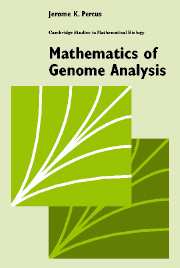5 - Spatial Structure and Dynamics of DNA
Published online by Cambridge University Press: 04 December 2009
Summary
Thermal Behavior
We have paid little attention to the way in which DNA transmits its information. There are many physicochemical steps involved, with a common theme of energy propagation and localization. Much activity has been devoted to the large-scale behavior of DNA, modeled, e.g., as a belt with elastic properties and giving rise to the “supercoiled” configuration responsible for placing linearly distant sections in close proximity, spatially. The double strand under such motions is stiff (“persistent”) at a resolution of some 50 bp. On the other hand, the overt mechanism of information transmission is that of transcription to RNA involving a “transcription bubble” or strand separation of only some 20 bp, activated by RNA polymerase contact. Of course, strand separation should be easier where it is required, and if we heat DNA – as a metaphor for uniform energy transfer – the “melting” is stepwise and nonuniform, presumably a function of the local properties of the (double) molecule. In fact, we might anticipate that such heterogeneous dynamics would appear even in homogeneous DNA, as this would imply greater sensitivity to external stimuli.
Quite different aspects are involved in the dynamics of DNA, RNA, and protein. The first minimally realistic model to be solved along these lines was that of local denaturation (H-bond breaking) of DNA, a requirement for strand separation to allow for transcription (Maddox, 1989, in Nature, said in effect that this work was the greatest discovery since the zipper).
Information
- Type
- Chapter
- Information
- Mathematics of Genome Analysis , pp. 118 - 128Publisher: Cambridge University PressPrint publication year: 2001
